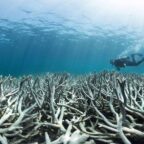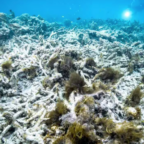
Repeated coral bleaching events owing to global warming are having lasting effects on reef fish communities, including changes in biodiversity and permanent shifts in the range of fish species, according to a new long-term study published on 18 June in Global Change Biology (1). Future reef fish communities will have fewer species, dominated by herbivores and invertebrate feeding fish.
The international team of researchers led by Dr James Robinson of Lancaster University carried out six surveys of 21 Seychelles reef sites from 1994 to 2017. They tracked the recovery of reefs over the 16-year period before the next major bleaching event in 2016 and discovered permanent shifts in the range of fish species cohabiting the coral reef sites.
The authors then used statistical models to compare changes in fish community compositions between recovering and regime‐shifted reefs over time. Previously, reef ecosystems were dominated by large predator fish like snappers and groupers and as well as very small fish such as damselfish and butterflyfish.
Post-bleaching, fish communities were taken over by algal-feeding parrotfish and rabbitfish and invertebrate-feeding fish such as emperors and wrasses. These new seaweed-dominated reefs were likely promoted by increases in tourism and local populations. And the survival of herbivore fish species during the first few years after bleaching may help sustain the larger herbivore populations over decades.
Although some reefs recovered, fish compositions were quite dissimilar to pre-bleached communities. Other reefs shifted to fields of seaweed and herbivore fish species became more dominant on all reefs. The authors suggest these conditions may now be the ‘new normal’ across damaged reefs around the world. Biodiversity losses were most severe on regime‐shifted reefs dominated by algae and new fish compositions were unlike those that existed before bleaching.
Furthermore, the time between bleaching events is decreasing, according to other studies — now, typically ten years under — under current levels of ocean warming. Despite the long period examined in the study — 18 years — between the coral bleaching events, the reefs were unable to recover. Even on reefs that partially recovered, numbers of fish species did not.
As the authors write, coral reefs are already being affected by more frequent and more intense warming events, which are expected to increase further as global temperature continues to rise. Since coral reefs operate close to thermal limits, they are more likely to reorganize and suffer local extinctions.
The paper suggests changes in coral reef communities will be unique, and indirectly driven by changes by collapsing habitat structures. Ecosystem protection of coral reefs, including fishing protection, could accelerate recovery towards pre-bleaching conditions – but will depend on the severity of bleaching, history of disturbances, as well as local anthropogenic stressors.
The findings are “stark” considering the biodiversity of coral reef fish communities did not return to pre-bleaching levels over the 16-year study period between two major climate-driven mass bleaching events in 1998 and 2016. Moreover, the results show that, at present, small-scale protected areas are insufficient to mitigate global climate change impacts for many coral reefs.
(1) Robinson, J.P.W. et al. Thermal stress induces persistently altered coral reef fish assemblages. Global Change Biology (2019). DOI: 10.1111/gcb.14704















Social Profiles